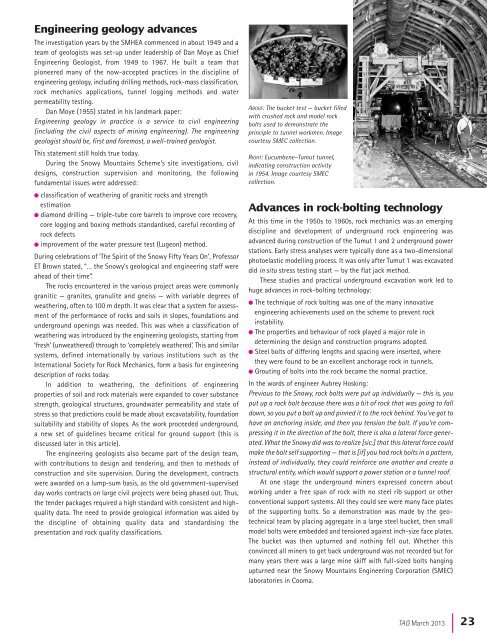TAG 166 - Geological Society of Australia
TAG 166 - Geological Society of Australia
TAG 166 - Geological Society of Australia
Create successful ePaper yourself
Turn your PDF publications into a flip-book with our unique Google optimized e-Paper software.
Engineering geology advancesThe investigation years by the SMHEA commenced in about 1949 and ateam <strong>of</strong> geologists was set-up under leadership <strong>of</strong> Dan Moye as ChiefEngineering Geologist, from 1949 to 1967. He built a team thatpioneered many <strong>of</strong> the now-accepted practices in the discipline <strong>of</strong>engineering geology, including drilling methods, rock-mass classification,rock mechanics applications, tunnel logging methods and waterpermeability testing.Dan Moye (1955) stated in his landmark paper:Engineering geology in practice is a service to civil engineering(including the civil aspects <strong>of</strong> mining engineering). The engineeringgeologist should be, first and foremost, a well-trained geologist.This statement still holds true today.During the Snowy Mountains Scheme’s site investigations, civildesigns, construction supervision and monitoring, the followingfundamental issues were addressed:l classification <strong>of</strong> weathering <strong>of</strong> granitic rocks and strengthestimationl diamond drilling — triple-tube core barrels to improve core recovery,core logging and boxing methods standardised, careful recording <strong>of</strong>rock defectsl improvement <strong>of</strong> the water pressure test (Lugeon) method.During celebrations <strong>of</strong> ‘The Spirit <strong>of</strong> the Snowy Fifty Years On’, Pr<strong>of</strong>essorET Brown stated, “… the Snowy’s geological and engineering staff wereahead <strong>of</strong> their time”.The rocks encountered in the various project areas were commonlygranitic — granites, granulite and gneiss — with variable degrees <strong>of</strong>weathering, <strong>of</strong>ten to 100 m depth. It was clear that a system for assessment<strong>of</strong> the performance <strong>of</strong> rocks and soils in slopes, foundations andunderground openings was needed. This was when a classification <strong>of</strong>weathering was introduced by the engineering geologists, starting from‘fresh’ (unweathered) through to ‘completely weathered’. This and similarsystems, defined internationally by various institutions such as theInternational <strong>Society</strong> for Rock Mechanics, form a basis for engineeringdescription <strong>of</strong> rocks today.In addition to weathering, the definitions <strong>of</strong> engineeringproperties <strong>of</strong> soil and rock materials were expanded to cover substancestrength, geological structures, groundwater permeability and state <strong>of</strong>stress so that predictions could be made about excavatability, foundationsuitability and stability <strong>of</strong> slopes. As the work proceeded underground,a new set <strong>of</strong> guidelines became critical for ground support (this isdiscussed later in this article).The engineering geologists also became part <strong>of</strong> the design team,with contributions to design and tendering, and then to methods <strong>of</strong>construction and site supervision. During the development, contractswere awarded on a lump-sum basis, as the old government-supervisedday works contracts on large civil projects were being phased out. Thus,the tender packages required a high standard with consistent and highqualitydata. The need to provide geological information was aided bythe discipline <strong>of</strong> obtaining quality data and standardising thepresentation and rock quality classifications.ABOVE: The bucket test — bucket filledwith crushed rock and model rockbolts used to demonstrate theprinciple to tunnel workmen. Imagecourtesy SMEC collection.RIGHT: Eucumbene–Tumut tunnel,indicating construction activityin 1954. Image courtesy SMECcollection.Advances in rock-bolting technologyAt this time in the 1950s to 1960s, rock mechanics was an emergingdiscipline and development <strong>of</strong> underground rock engineering wasadvanced during construction <strong>of</strong> the Tumut 1 and 2 underground powerstations. Early stress analyses were typically done as a two-dimensionalphotoelastic modelling process. It was only after Tumut 1 was excavateddid in situ stress testing start — by the flat jack method.These studies and practical underground excavation work led tohuge advances in rock-bolting technology:l The technique <strong>of</strong> rock bolting was one <strong>of</strong> the many innovativeengineering achievements used on the scheme to prevent rockinstability.l The properties and behaviour <strong>of</strong> rock played a major role indetermining the design and construction programs adopted.l Steel bolts <strong>of</strong> differing lengths and spacing were inserted, wherethey were found to be an excellent anchorage rock in tunnels.l Grouting <strong>of</strong> bolts into the rock became the normal practice.In the words <strong>of</strong> engineer Aubrey Hosking:Previous to the Snowy, rock bolts were put up individually — this is, youput up a rock bolt because there was a bit <strong>of</strong> rock that was going to falldown, so you put a bolt up and pinned it to the rock behind. You’ve got tohave an anchoring inside, and then you tension the bolt. If you’re compressingit in the direction <strong>of</strong> the bolt, there is also a lateral force generated.What the Snowy did was to realize [sic.] that this lateral force couldmake the bolt self supporting — that is [if] you had rock bolts in a pattern,instead <strong>of</strong> individually, they could reinforce one another and create astructural entity, which would support a power station or a tunnel ro<strong>of</strong>.At one stage the underground miners expressed concern aboutworking under a free span <strong>of</strong> rock with no steel rib support or otherconventional support systems. All they could see were many face plates<strong>of</strong> the supporting bolts. So a demonstration was made by the geotechnicalteam by placing aggregate in a large steel bucket, then smallmodel bolts were embedded and tensioned against inch-size face plates.The bucket was then upturned and nothing fell out. Whether thisconvinced all miners to get back underground was not recorded but formany years there was a large mine skiff with full-sized bolts hangingupturned near the Snowy Mountains Engineering Corporation (SMEC)laboratories in Cooma.<strong>TAG</strong> March 2013| 23
















